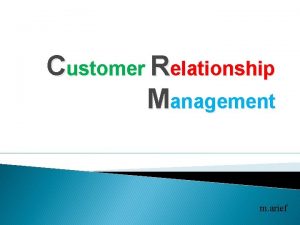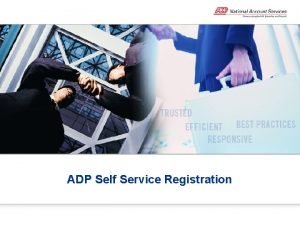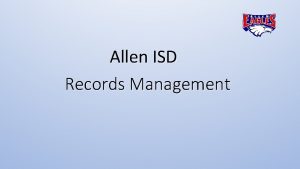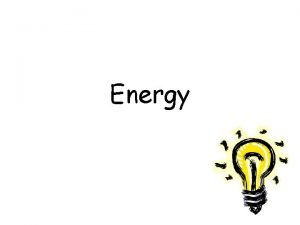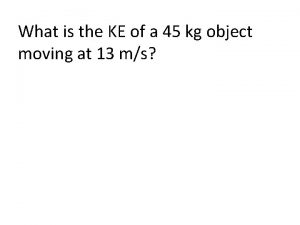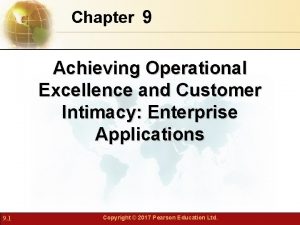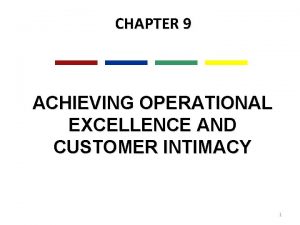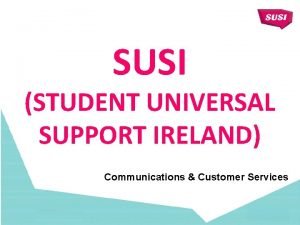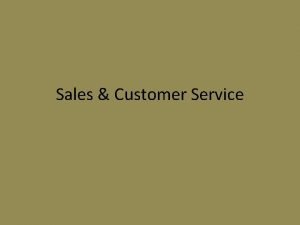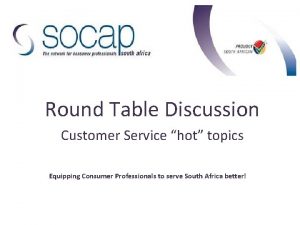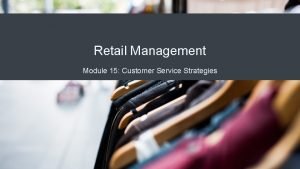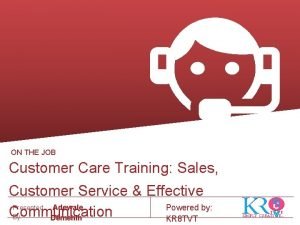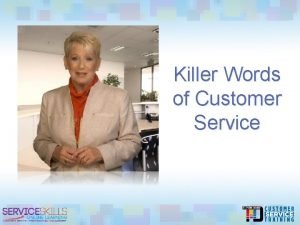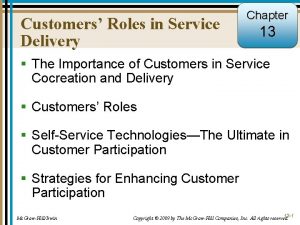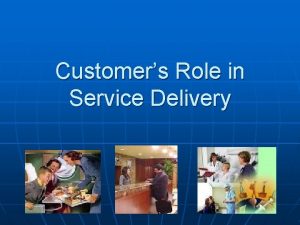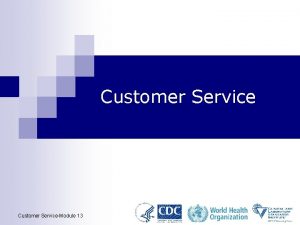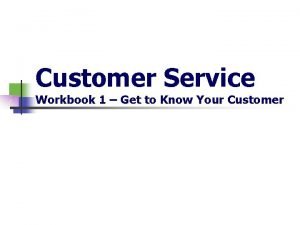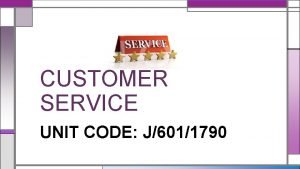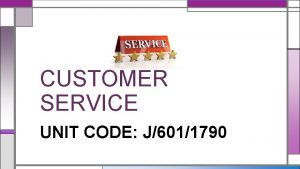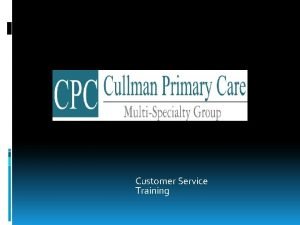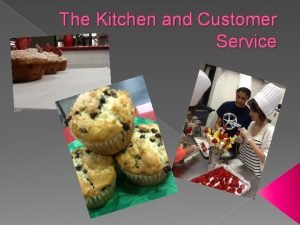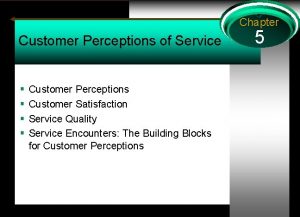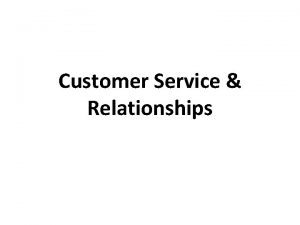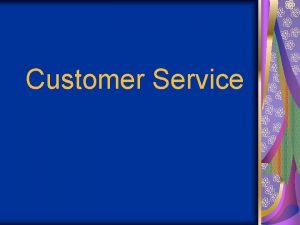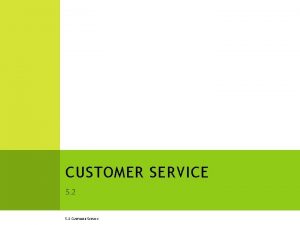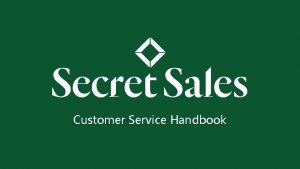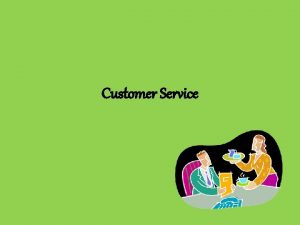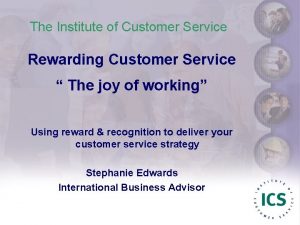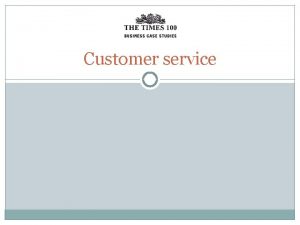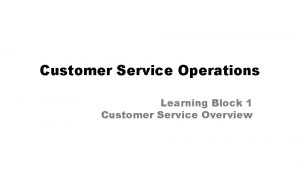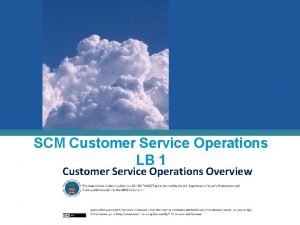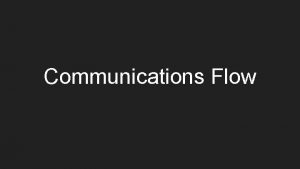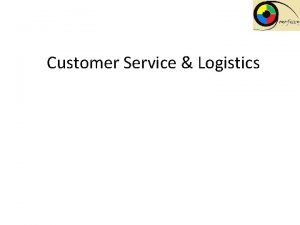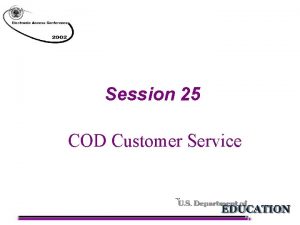Superior Customer Service Missy Allen District 65 1192020









































- Slides: 41

Superior Customer Service Missy Allen District 65 11/9/2020

Module Objectives: • What quality customer service is and why it is important • How to send a positive attitude • How to identify customer needs • How to satisfy customer needs • How to ensure customers will return 11/9/2020

Exercise: Turn to page 6 of your workbook and assess your attitude about customer relations. Regardless of your score, you will learn and practice skills in this course that will improve your potential for good customer relations. 11/9/2020

What is quality customer service? • Think back over the past several weeks and identify a situation when you were a customer and you received excellent service. • What was the experience? What did the service provider do to provide the excellent service? 11/9/2020

From the list we just created, there appears to be many elements that make up quality service. Lets look at two dimensions of service. • Procedural dimension • Personal dimension 11/9/2020

Procedural Dimension: • The procedural side of service consists of the established system and procedures to deliver products and/or service. 11/9/2020

Personal Dimension: • The personal side of service is how service personnel (using their attitudes, behaviors, and verbal skills) interact with customers. 11/9/2020

Example #1: Procedural (A) Personal Drawing A reflects an operation that is low in both personal and procedural service. This “freezer” approach to service communicates to customers, “We don’t care. ” 11/9/2020

Example #2 Procedural (B) Personal Drawing B represents proficient procedural service but a weakness in the personal dimension. This “factory” approach to service communicates to customers, “You are a number. We are here to process you. ” 11/9/2020

Example #3: Procedural (C) Personal Drawing C is the “friendly zoo” approach. It is very personal but lacks procedural consistency. This type of service communicates to customers, “We are trying hard, but don’t really know what we’re doing. ” 11/9/2020

Example #4: Procedural (D) Personal 11/9/2020 Drawing D represents Quality Customer Service. It is strong in both the personal and the procedural dimensions. It communicates to members, “We care and we deliver. ”

Why is Quality Customer Service Important? What happens when a business loses customers? • The lifeblood of any company is repeat business. Expanding the customer base is vital. This means companies not only have to attract new clients or customers, but also must keep existing ones. Quality service helps make this happen. 11/9/2020

Competition • Whenever there is competition for a product or service, the quality of how you deliver service is going to make a difference to the bottom line. • Who is your competition? Do you think the quality of your service makes a difference in attracting and retaining customers? Read the statements on page 12 and determine which are true and which are false. What additional benefits can you add to this list? 11/9/2020

Video: Send a Positive Attitude • This introduction to Quality Customer Service recaps why quality service is important. A combination of real-world interviews and demonstrations of service skills reinforce the discussion points earlier in this session. Send a Positive Attitude demonstrates both good and bad examples of projecting a positive attitude to customers. It states: The single worst service mistake is indifference. Two thirds of all customers who don’t come back say it’s because service people didn’t seem to care about their needs. 11/9/2020

Sending a positive attitude: • Can you think of a person that you worked with that has a very positive attitude? What does that person do that tells you they have a good attitude? • What about your attitude? The attitude you project to others depends primarily on the way you look at your job. Rate yourself attitude on page 19. Rate yourself on appearance on page 21. 11/9/2020

Sending a positive attitude: • One good way to send a positive attitude is by your appearance. You never get a second chance to create a positive first impression. • Your body language accounts for more than half of the message you communicate. 11/9/2020

Sending a positive attitude: When your face is relaxed and under control, what message does it communicate? What about when you smile naturally? What about eye contact? What about body movement that is relaxed, yet deliberate and controlled? What message does the opposite body language send? 11/9/2020

Attitude in your voice: The tone of your voice, or how you say something, is often more important than the words you use. A tone that is conductive to your success in customer relations can be described by any of these four characteristics: 1. It is upbeat. 2. It is warm, comfortable and understanding. 3. It is under control. 4. It is clear, direct and natural. 11/9/2020

Attitude in your voice: Why is your attitude so important in using the telephone? 1. You have only your voice to rely on. Body language, written messages and visual aids are unavailable. 2. When you are on the phone with a customer or client, you are the single representative of your company. In other words, you are your organization. Turn to page 27 and take the telephone quiz. 11/9/2020

Staying Energized: There are some myths that are associated with customer service jobs. One is that it is less tiring than other jobs that require hard physical labor. The reality is that customer service requires the exertion of emotional labor. Emotional labor takes its toll on your energy level just like physical labor does. Servicing many customers over an extended period of time can be very tiring. When you have exhausted your reservoir of emotional energy, it is called contact overload syndrome. 11/9/2020

Staying Energized: When you are suffering from contact overload syndrome you can become • tired • listless • dejected • grouchy/impatient • even clumsy In this next exercise we will develop some strategies to reenergize ourselves. 11/9/2020

Staying Energized: Take these next few minutes to answer the following questions: 1. How is contact overload syndrome a potential problem for you? 2. When you are emotionally tired, what can you do to re-energize yourself? 11/9/2020

Identify customer needs: There are four basic customer needs: • To be understood • To feel welcome • To feel important • To feel comfortable Real-world interviews and demonstrations highlight the key elements of identifying customer needs: • Timeless • Attentiveness • Skillful listening 11/9/2020 • Getting feedback View the next segment of the video: Identify Customer needs.

Timeliness Knowing the service time requirements for your operation is critical to performing quality service. Some examples of requirements are: 1. How soon a customer is greeted. 2. Number of minutes to complete initial paperwork. 3. Time for special requests to be handled. 4. Maximum number of rings before telephone is answered. What are some of the time requirements in your job? Why are these targets important? You may lose customers if your service does not meet their time requirements. 11/9/2020

One Step Ahead: Quality service involves anticipating customer needs, not just responding when it is requested. Ask yourself these questions: 1. Have I considered all of the customer’s needs? 2. What will the guest need next? 3. How can I improve service now for my client? How do you anticipate the needs of your customers? Basic customer needs: As the video explained to us, customers have four basic needs. Does anyone remember what those are? 11/9/2020

Basic Customer Needs: 1. The need to be understood. Those who select your service need to feel they are communicating effectively. Emotions or language barriers can get in the way of proper understanding. 2. The need to feel welcome. Anyone doing business with you who feels like an outsider will not return. People need to feel you are happy to see them and that their business is important to you. 3. The need to feel important. Ego and self-esteem are powerful human needs. We all like to feel important. Anything you can do to make a guest feel special is a step in the right direction. 11/9/2020

Basic Customer Needs: 4. The need for comfort. Customers need physical comfort: a place to wait, rest, talk or do business. They also need psychological comfort: the assurance they will be taken care of properly, and the confidence you will meet their needs. What do your customers do or say that indicate to you one of these basic needs? *refer to page 86 for examples. The purpose of this discussion is to learn how to relate a customer’s behavior with one of these basic needs. In the next section, you will learn how to satisfy that need once it has been identified. 11/9/2020

Skillful Listening: Listening is one of the best ways to identify customer needs. That statement seems simple on the surface, doesn’t it. Unfortunately, many of us take listening for granted. Let’s look at some of the common myths about listening skills on page 45. Read page 45 and circle the correct assumptions you think will help you most improve your listening skills. 11/9/2020

Obtaining Feedback: Listening to customer feedback is another important way to identify customer needs. Some common ways to obtain feedback are listed on page 48. Answer the following questions: 1. Which of the ideas on page 48 are appropriate to our jobs? 2. What other ways can we solicit feedback from our customers? 11/9/2020

Satisfy Customer Needs: More Video… In this next segment we meet author Bill Martin, professor of Hotel, Restaurant, and Travel Management at Cal Poly, Pomona, California. Bill shares his insights on being a success at satisfying customers. We also learn the difference between features and benefits: • Features are product-related. • Benefits are customer-related. “What this means to you is…. ” We are also reminded to not take our “internal” customers for granted, but give them the same quality service we give our external customers. 11/9/2020

Satisfy Customer Needs: What Services Do You Provide? Now that you have identified what you provide, let’s discuss some tips that can help you improve the quality of what you provide. Do you ask for additional business when an existing insured calls in? Do you ask them if there is anything new going on that may require an FFR and further changes to their policy? Do you tell your new insured’s that we write all lines of insurance? 11/9/2020

Satisfy Customer Needs: Back-up Duties: Treating customers special means performing back-up tasks with as much positive energy and interest as you demonstrate in other aspects of your job. What are some of the back-up task you normally perform? Why do you think it is an important aspect of customer service to do these well? 11/9/2020

Satisfy Customer Needs: Communicating: The way in which you communicate can make or break your success on the job. Read the statements on page 59 and mark the ones you think are true. Circle the ones you think are most important. 11/9/2020

Satisfy Customer Needs: Meeting Basic Needs: Earlier we talked about the four basic needs of customers. Now we are going to discuss ways you can meet those basic needs. How can you show understanding to a customer? How can you make your guests or customers feel welcome? How can you help make your customer feel important? How can you provide a comfortable environment? 11/9/2020

Satisfy Customer Needs: Features and Benefits: Read the explanation of features and benefits at the top of page 65. Pick one of the services you provide and list the features and the benefits of that service. Would anyone like to volunteer to “sell” this service? 11/9/2020

Making Sure Customers Come Back Why Customers Return: Think about your regular customers. • What do they have in common? • Why do you think they return? Turn to page 73. Check off the actions you have performed for those customers who return regularly. Do you think you personally are one of the reasons these customers return? 11/9/2020 *If you treat all customers like this, you can ensure that customers return!

Making Sure Customers Come Back Why Customers Return: Video Summary: In this final segment we learn that it costs six times more to attract a new customer than to keep a current one. An important step in keeping our customers coming back is to handle their complaints well. Take complaints professionally, not personally and follow the steps outlined in the next discussion. 11/9/2020

Making Sure Customers Come Back Handling Complaints Steps for handling complaints that were reviewed in the video: • Listen Carefully to the complaint. • Repeat back the complaint and get acknowledgement that you heard it correctly. • Apologize. • Acknowledge their feelings. • Explain actions you will take. • Thank the guest for their patience. What are some reasons that one of your customers might complain? 11/9/2020

Making Sure Customers Come Back Read the case study on page 75 and develop an action plan for responding to this upset customer. Take turns practicing with a partner. The customer will reenact the situation on page 75. The Skill Builder will practice the five steps for handling complaints. The Customer will respond to the Skill Builder in a realistic way. Discuss ways of resolving the situation as a group. 11/9/2020

Making Sure Customers Come Back Taking that one extra service step: Read pate 80 -82. Think about how you can take that extra step of service. Planning: Turn to page 84. Think about the key things you have learned in this session and choose two or three that you will focus on using in the future. 11/9/2020 Identify things you want to discuss with your manager. List these in the box on page 85.

Summing It All Up! Look at objectives, evaluate this session Look back at your expectations of this session. Which have been met? Which will need further exploration? • What is quality customer service and why is it important? • How to send a positive image. • How to identify customer needs. • How to satisfy customer needs. • How to ensure customers will return. Have these objectives been accomplished? Write down on a piece of paper what you gained from this session. What are your recommendations for improvement? 11/9/2020
 9:09 pm
9:09 pm über allen gipfeln ist ruh youtube
über allen gipfeln ist ruh youtube Perbedaan customer relation dan customer service
Perbedaan customer relation dan customer service Adp self portal login
Adp self portal login Allen isd service center
Allen isd service center Missy diwater
Missy diwater What is the theme of money mark and penny petal
What is the theme of money mark and penny petal Missy diwater the former platform diver
Missy diwater the former platform diver Missy baker
Missy baker Centripetal force period
Centripetal force period Missy ward
Missy ward Missy diwater
Missy diwater Missy petty
Missy petty Missy ward
Missy ward Marketing information and customer insights are
Marketing information and customer insights are Customer relationship management and customer intimacy
Customer relationship management and customer intimacy Beyond customer satisfaction
Beyond customer satisfaction Customer relationship management and customer intimacy
Customer relationship management and customer intimacy Customer relationship management and customer intimacy
Customer relationship management and customer intimacy Lso customer service
Lso customer service Swot analysis between nike and adidas
Swot analysis between nike and adidas Susi login
Susi login Remarkable customer support
Remarkable customer support Sbcglobal customer support phone number
Sbcglobal customer support phone number Types of customers in customer service
Types of customers in customer service Customer service discussion topics
Customer service discussion topics Customer service strategies in retail
Customer service strategies in retail Resident customer service
Resident customer service Good and bad customer service videos
Good and bad customer service videos Customer service language
Customer service language Contoh killer words
Contoh killer words Health equity customer service
Health equity customer service Swot analysis hbr
Swot analysis hbr Ga gateway customer service
Ga gateway customer service Allergan customer service
Allergan customer service Customer roles in service delivery
Customer roles in service delivery Role of customer in service delivery
Role of customer in service delivery Customer service module
Customer service module Customer service level 1 workbook
Customer service level 1 workbook A customer is someone who
A customer is someone who Customer care policy
Customer care policy Unit 7 aviation
Unit 7 aviation


